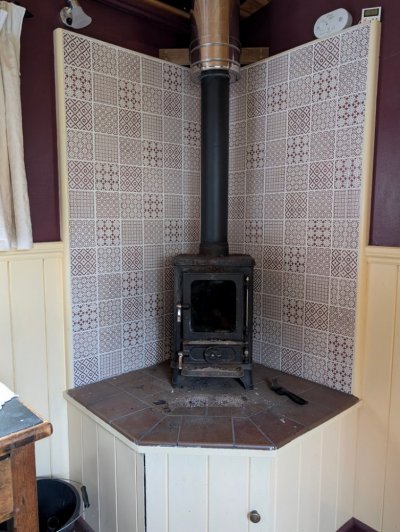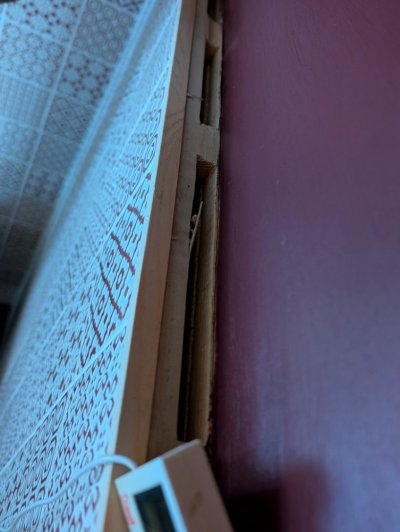Cubist
Member
- Messages
- 2,498
- Location
- Shropshire/Herefordshire Border
That's not a hut surely? I'd be calling it a sauna.When the stove is lit and burning well, the hut quickly reaches a temperature in the high 20s,
That's not a hut surely? I'd be calling it a sauna.When the stove is lit and burning well, the hut quickly reaches a temperature in the high 20s,
Yeah I hear you on this, I would really prefer a professional to do it but 2k is too rich for my blood I think. Especially when combined with the extra cost and time of tiling.At the risk of being a contrarian - at its most basic you are installing these facilities because you want to regularly light fires within a building...
Personally I’d just put whatever did the job (tiles/board whatever) and was visually the least displeasing for me and move on.
Maybe it is belt and braces, maybe he was talking twaddle but for less than £100 of materials and max a couple hours of your time is it worth arguing about?
If the whole thing is twin wall like you say rather than just the internal section that’s probably not an outrageous quote these days
Thank you sir. On the pipe diameter, the actual diameter of the exist from the stove is 5 inches but both this guy and another told me insulated double-walled pipe only comes in 6 inch diameter so I think I’ll need sone kind of adapter or something.Based on what @Glenn586 has said regarding HETAS certification AND that there was a building there AND you have not converted it for use as accommodation then I would just get on with it and not, as @a twig says don't tell em Pike.
On a technical note I'm guessing that the flue pipes needed are 6inch. I've inserted a link below to an on-line provider to give you an idea of the components you may need but would suggest you plan on the basis of where you would ideally place the final exit through the wall and check to see how many stand-off brackets you may need to support the external pipe TO the desired height above the buildings ridge line.
Stainless Steel Twin Wall Flue Pipes - Machine Mart
Top quality stainless steel high temperature insulated twin wall flue pipes.www.machinemart.co.uk
Wait so is this air gap between the cement boards visible or has it been covered in some way to look like a small “shelf”?I built a shepherds hut some years ago and installed a 'Hobbit' wood burner, about the smallest available. The entire structure of the hut is wood (except for the outside corrugated iron sheeting) so I was careful to follow the installation guidance even though it has not been 'signed off'. I lined the corner area around the stove with 12mm cement board. One layer fixed to the timber frame then a second layer over the top spaced by using small pieces of the same cement board as 'thick washers' around the fixing screws to create a 12mm air gap. The stove sits on a plinth constructed from 18mm ply that butts up to the outer layer of cement board such that the 12mm air gap is open at the bottom to allow air to rise behind it. Similarly, the gap at the top of the cement boards was only partially covered, to allow air to flow behind the gap between the boards. I then tiled the plinth to form a hearth and tiled the cement boards. The wall tiles extended above the single skin flue from the stove to just above where it met the double-skinned flue that extended through the roof of the hut..
When the stove is lit and burning well, the hut quickly reaches a temperature in the high 20s, even in winter making it really very cosy. The wall tiles around the stove, however, become too hot to touch, which concerned me at first so I used a temperature probe inserted down the air gap between the cement boards to measure the temperature and it was between 30-40c at the hottest point so I stopped worrying.
The hut has been used many times as a spare bedroom thoughout the year whenever we have too many house guests without problems (usually with the hut being over-subscribed with eager volunteers!). Even the CO monitor/alarm has never gone off.
All of which is a long-winded way of saying don't underestimate how hot even non-combustible materials can become in the vicinity of a roaring stove and also bear in mind how that heat will be conducted to the inside of whatever non-combustible material you're using. Unless you have something akin to the Space Shuttle thermal tiles, I reckon an air gap is fairly essential if you need to protect combustible materials from excessive heat and preferably arranged to allow air to flow between the gaps by convection.
From time to time, I've measured the surface temperature of the wall above my stove. Close to the ceiling, 50-60°C. Just above the stove, 120°C or higher is not that unusual - And this is with burning wood (stopped using coal when it hit £15 per bag).All of which is a long-winded way of saying don't underestimate how hot even non-combustible materials can become in the vicinity of a roaring stove and also bear in mind how that heat will be conducted to the inside of whatever non-combustible material you're using. Unless you have something akin to the Space Shuttle thermal tiles, I reckon an air gap is fairly essential if you need to protect combustible materials from excessive heat and preferably arranged to allow air to flow between the gaps by convection.
Ok and what’s on the wall?From time to time, I've measured the surface temperature of the wall above my stove. Close to the ceiling, 50-60°C. Just above the stove, 120°C or higher is not that unusual - And this is with burning wood (stopped using coal when it hit £15 per bag).
Wait so is this air gap between the cement boards visible or has it been covered in some way to look like a small “shelf”?


Oh gotcha, so it's only visible from above. Is there some theoretical reason you didn't seal off that gap at the top (like letting hot air escape)? Or it was just not worth the bother because nobody ever stands up on a bench to look down at your work from above?The tiles extend up to the wall to just above eye height so the gap between the boards is not normally visible. It does mean the tiles jut out from the wall slightly, but it's hardly noticeable in the grand scheme of things and, with a bit of wood trim around the tiles, I don't consider it to be an issue.
View attachment 15856
View attachment 15857
That's BS. Five inch pipe is available from a number of stockists. Check out these guys.Thank you sir. On the pipe diameter, the actual diameter of the exist from the stove is 5 inches but both this guy and another told me insulated double-walled pipe only comes in 6 inch diameter so I think I’ll need sone kind of adapter or something.

Why must they always lie to me? What’s wrong with the truth?That's BS. Five inch pipe is available from a number of stockists. Check out these guys.

5 inch (125 mm)Twin Wall Flue Insulated Flue System | Stainless Steel
National Chimney Supplies is a family run operation with over 10 Years plus experience of installing Wood burning Stoves and Biomass Boiler'snationalchimneysupplies.com
Easy option tradesmen with exploitative attitudes toward the unknowing and innocent - that and Americans are sometimes considered easy meat since that chap bought London Bridge not Tower Bridge as he'd thought.Why must they always lie to me? What’s wrong with the truth?
Yes, this is my suspicion as well. Fragile little egos that can't handle basic inquiries about methods, materials and approaches.Also, in my experience, they don't seem to like a prospective customer to know what they're talking about, or if they answer questions they can't answer, which puts them on the back foot. Then they just disappear and the priomised quotes are not forthcoming and emails/telephone calls are not answered.
I guess when there is plenty of work available they can pick and choose their jobs and avoid anything that might not be quick and simple.
Wonderful. I guess it's time to start perfecting my Welsh accent...Easy option tradesmen with exploitative attitudes toward the unknowing and innocent - that and Americans are sometimes considered easy meat since that chap bought London Bridge not Tower Bridge as he'd thought.
Haven't you met enough Welsh cowboys already? More than a few Englishmen, Scotsmen and Irishmen with imitation stetsons already - but that's another joke altogether.Wonderful. I guess it's time to start perfecting my Welsh accent...
You shouldn't tempt me so.... Oh soddit; you guys ever seen the promotional tv ad EDS used donkeys years ago of a cowboy herding cats? An image of @aockenden just popped into my head of a chap in chaps riding a sheep trying to corral an unruly bunch of plumbers, leccies and the like.I used to joke about installing a 'hitching rail' at the front of the house . . .
